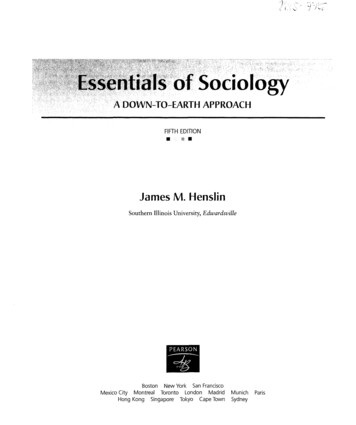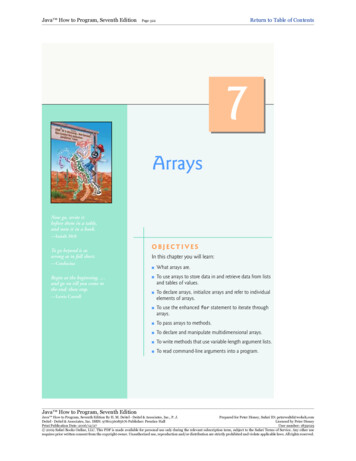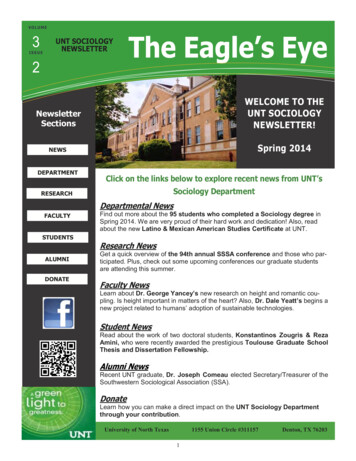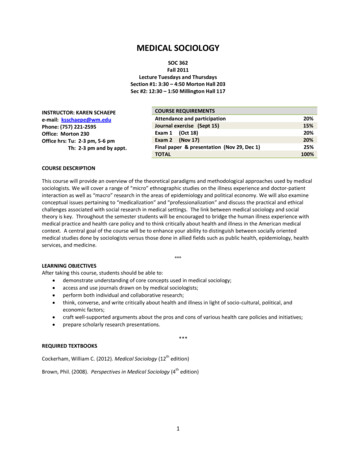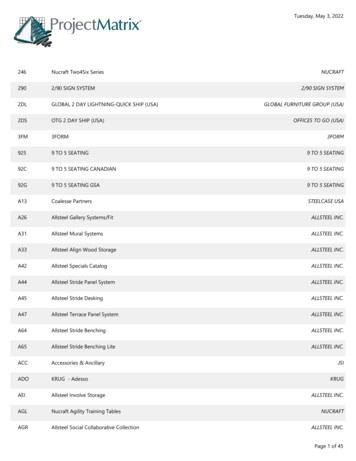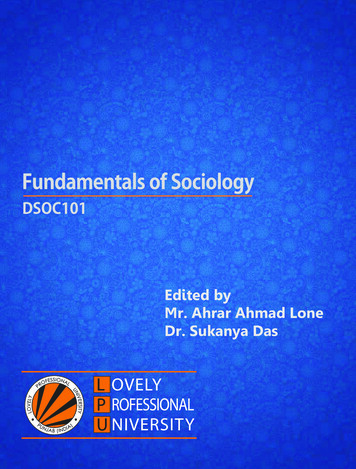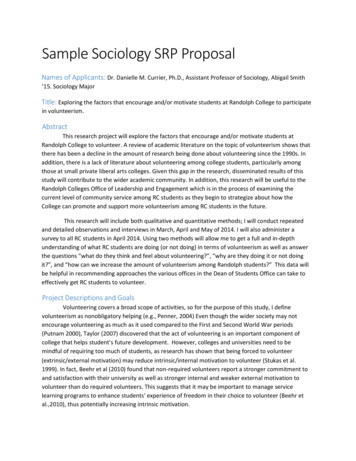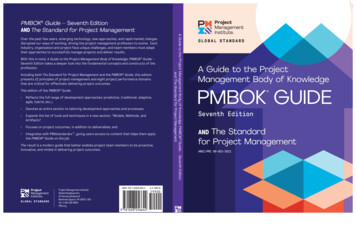
Transcription
Essentials of sociology seventh edition pdf
Essentials of sociology seventh edition pdf. What is the essential wisdom of sociology.About the Author: Anthony Giddens, former director of the London School of Economics and a current member of the House of Lords, is a world-renowned social theorist who has written over forty books. He has written on just about every major topic in sociology but is best known for his work on modernization theory and globalization.MitchellDuneier is an award-winning urban ethnographer at Princeton University and the City University of New York Graduate Center. He is most famous for his book Sidewalk, which won the Los Angeles Times Book Prize. Duneier's research focuses on the urban poor and other groups in the margins of society.Richard P. Appelbaum, the MacArthur chair ofGlobal Studies at the University of California, Santa Barbara, has won several awards for his teaching and works mainly on globalization and labor issues. Appelbaum is the coauthor of Behind the Label.Deborah Carr is a demographer and an active teacher at Rutgers University, where she regularly teaches the intro course. Her work focuses onsociology of the life course, aging, social psychology, and gender. Carr's latest book, Worried Sick: How Stress Hurts Us and How to Bounce Back, looks at how stress gets under our skin, makes us sick, and how and why people cope with stress differently. "About this title" may belong to another edition of this title. Seller Condition Total (w/tax) Ships2-3 days Used 17.00 Seller Comments: Connecting readers with great books since 1972! Used books may not include companion materials, and may have some shelf wear or limited writing. We ship orders daily and Customer Service is our top priority! Ready to ship Rental 90 Days 18.25 Seller Comments: Books may be in new or used condition.CD's, Access Codes, etc may not be included with the rentals. Books are required to be returned at the end of the rental period. Ships 2-3 days International 19.48 Seller Comments: Multiple available! Minor damage but still usable. May contain water damage, writing/highlighting or have a cut corner. ISBN 0393674088 Essentials of Sociology. FairShips 2-3 days Used 19.71 Seller Comments: Multiple available! Very minor wear. ISBN 0393674088 Essentials of Sociology. Very Good Ships 2-3 days International 19.95 Seller Comments: Multiple available! Minor damage but still usable. May contain water damage, writing/highlighting or have a cut corner. ISBN 0393674088 Essentials ofSociology Ships 2-3 days Used 20.18 Seller Comments: Multiple available! Very minor wear. ISBN 0393674088 Essentials of Sociology Ships 2-3 days Used 20.99 Ships 2-3 days Rental 90 Days 22.42 Seller Comments: eCampus Rental Ready to ship Used 34.49 Seller Comments: All books are in a good used condition, may have highlighting.Books are sold with a 21 day guarantee. Ships 2-3 days Used 52.99 Ready to ship Used 66.36 Seller Comments: Used books are considered in good condition even when they contain highlighting, margin notes or other markings. We cannot guarantee that additional materials originally included in a package will be included in your package. Ships 23 days Used 79.00 Ships 2-3 days New 103.24 Seller Comments: Ships in a BOX from Central Missouri! Ships same or next business day. UPS shipping for most packages, (Priority Mail for AK/HI/APO/PO Boxes). New Table of contents : Publisher's NoticeHalftitle PageRecent Sociology Titles from W. W. NortonTitle PageCopyrightPageContentsPrefaceChapter 1: Sociology: Theory and MethodWhat Is the â œSociological Imaginationâ ?What Theories Do Sociologists Use?What Kinds of Questions Can Sociologists Answer?What Are the Steps of the Research Process?What Research Methods Do Sociologists Use?What Ethical Dilemmas Do Sociologists Face?How Does theSociological Imagination Affect Your Life?The Big PictureChapter 2: Culture and SocietyWhat Is Culture?How Does Human Culture Develop?What Happened to Premodern Societies?How Has Industrialization Shaped Modern Society?How Does Globalization Affect Contemporary Culture?The Big PictureChapter 3: Socialization, the Life Course, andAgingHow Are Children Socialized?What Are the Five Major Stages of the Life Course?How Do People Age?What Are the Challenges of Aging in the U.S.?The Big PictureChapter 4: Social Interaction and Everyday Life in the Age of the InternetWhat Is Social Interaction and Why Study It?How Do We Manage Impressions in Daily Life?What RulesGuide How We Communicate with Others?How Do Time and Space Affect Our Interactions?How Do the Rules of Social Interaction Affect Your Life?The Big PictureChapter 5: Groups, Networks, and OrganizationsWhat Are Social Groups?How Do We Benefit from Social Networks?How Do Organizations Function?Is Bureaucracy an Outdated Model?How Do Organizations and Groups Affect Your Life?ConclusionThe Big PictureChapter 6: Deviance, Crime, and PunishmentWhat Is Deviance?Why Do People Commit Deviant Acts?How Do We Document Crime?Who Are the Perpetrators?What Were the Causes and Costs of the Great Crime Decline?How Do Crime and Deviance Affect Your Life?TheBig PictureChapter 7: Stratification, Class, and InequalityWhat Is Social Stratification?How Is Social Class Defined in the United States?What Are the Causes and Consequences of Social Inequality in the United States?How Does Poverty Affect Individuals?How Does Social Inequality Affect Your Life?The Big PictureChapter 8: Global InequalityWhat IsGlobal Inequality?What Is Daily Life Like in Rich vs. Poor Countries?Can Poor Countries Become Rich?How Do Sociological Theories Explain Global Inequality?What Does Rapid Globalization Mean for the Future of Global Inequality?The Big PictureChapter 9: Gender InequalityAre Gender Differences Due to Nature, Nurture, or Both?How Do GenderInequalities Play Out in Social Institutions?Why Are Women the Target of Violence?How Does Social Theory Explain Gender Inequality?How Can We Reduce Gender-Based Aggression?The Big PictureChapter 10: Race, Ethnicity, and RacismWhat Are Race and Ethnicity?Why Do Racial and Ethnic Antagonism Exist?How Does Racism Operate inAmerican Society Today?What Are the Origins and Nature of Ethnic Diversity in the United States?How Do Race and Ethnicity Affect the Life Chances of Different Groups?How Do Sociologists Explain Racial Inequality?The Big PictureChapter 11: Families and Intimate RelationshipsHow Do Sociological Theories Characterize Families?How HaveFamilies Changed over Time?What Do Marriage and Family in the United States Look like Today?Why Does Family Violence Happen?How Do New Family Forms Affect Your Life?The Big PictureChapter 12: Education and ReligionWhy Are Education and Literacy So Important?What Is the Link between Education and Inequality?How Do SociologistsThink about Religion?How Does Religion Affect Life throughout the World?How Does Religion Affect Your Life in the United States?The Big PictureChapter 13: Politics and Economic LifeHow Did the State Develop?How Do Democracies Function?What Is the Social Significance of Work?What Are Key Elements of the Modern Economy?How Does WorkAffect Everyday Life Today?The Big PictureChapter 14: The Sociology of the Body: Health, Illness, and SexualityHow Do Social Contexts Affect the Human Body?How Do Sociologists Understand Health and Illness?How Do Social Factors Affect Health and Illness?How Do Social Contexts Shape Sexual Behavior?The Big PictureChapter 15:Urbanization, Population, and the EnvironmentHow Do Cities Develop and Evolve?How Do Rural, Suburban, and Urban Life Differ in the United States?How Does Urbanization Affect Life across the Globe?What Are the Forces behind World Population Growth?How Do Environmental Changes Affect Your Life?The Big PictureChapter 16: Globalizationin a Changing WorldHow Does Globalization Affect Social Change?Why Does Terrorism Seem to Be on the Rise in the World Today?What Are Social Movements?What Factors Contribute to Globalization?How Does Globalization Affect Your Life?The Big PictureGlossaryBibliographyCreditsIndex Citation preview Publisher's Notice Please note that thisversion of the ebook does not include access to any media or print supplements that are sold packaged with the printed book. 2 3 4 Recent Sociology Titles from W. W. Norton The Contexts Reader, Third Edition edited by Syed Ali and Philip N. Cohen Code of the Street by Elijah Anderson In the Trenches: Teaching and Learning Sociology by MaxineP. Atkinson and Kathleen S. Lowney Social Problems, Third Edition by Joel Best The Art and Science of Social Research by Deborah Carr, Elizabeth Heger Boyle, Benjamin Cornwell, Shelley Correll, Robert Crosnoe, Jeremy Freese, and Mary C. Waters You May Ask Yourself: An Introduction to Thinking like a Sociologist, Sixth Edition by Dalton ConleyThe Family: Diversity, Inequality, and Social Change, Second Edition by Philip N. Cohen Race in America by Matthew Desmond and Mustafa Emirbayer Gender: Ideas, Interactions, Institutions, Second Edition by Lisa Wade and Myra Marx Ferree The Real World: An Introduction to Sociology, Sixth Edition by Kerry Ferris and Jill Stein Mix It Up:Popular Culture, Mass Media, and Society, Second Edition by David Grazian Readings for Sociology, Eighth Edition edited by Garth Massey Families as They Really Are, Second Edition edited by Barbara J. Risman and Virginia E. Rutter 5 Sex Matters: The Sexuality and Society Reader, Fifth Edition edited by Mindy Stombler, Dawn M. Baunach,Elisabeth O. Burgess, Wendy Simonds, and Elroi J. Windsor Cultural Sociology: An Introductory Reader edited by Matt Wray American Society: How It Really Works, Second Edition by Erik Olin Wright and Joel Rogers To learn more about Norton Sociology, please visit wwnorton.com/soc 6 7 8 W. W. NORTON & COMPANY has been independent sinceits founding in 1923, when Wiliam Warder Norton and Mary D. Herter Norton first published lectures delivered at the People’s Institute, the adult education division of New York City’s Cooper Union. The firm soon expanded its program beyond the Institute, publishing books by celebrated academics from America and abroad. By midcentury, the twomajor pillars of Norton’s publishing program—trade books and college texts—were firmly established. In the 1950s, the Norton family transferred control of the company to its employees, and today—with a staff of five hundred and hundreds of trade, college, and professional titles published each year—W. W. Norton & Company stands as the largestand oldest publishing house owned wholly by its employees. Copyright 2019, 2017, 2015, 2013, 2011, 2008 by Anthony Giddens, Mitchell Duneier, Richard P. Appelbaum, and Deborah Carr Copyright 2006 by Anthony Giddens, Mitchell Duneier, and Richard P. Appelbaum All rights reserved Cover image: enjoynz/Stock/Getty Images Plus Coverdesign: Pete Garceau Editor: Sasha Levitt Assistant Editor: Erika Nakagawa Project Editor: Diane Cipollone Managing Editor, College: Marian Johnson Managing Editor, College Digital Media: Kim Yi Production Manager: Stephen Sajdak Media Editor: Eileen Connell Associate Media Editor: Ariel Eaton Media Editorial Assistant: Samuel Tang MediaProject Editor: Danielle Belfiore Ebook Designer: Juan Paolo Francisco Ebook Production: Michael Hicks Marketing Manager, Sociology: Julia Hall Design Director: Hope Miller Goodell, Rubina Yeh Photo Editor: Cat Abelman Director of College Permissions: Megan Schindel Permissions Assistant: Patricia Wong 9 Information Graphics Design: Kiss MeI’m Polish LLC, New York Composition: Graphic World The Library of Congress has cataloged the printed edition as follows: Names: Giddens, Anthony, author. Title: Essentials of sociology / Anthony Giddens [and three others]. Description: Seventh edition. New York : W.W. Norton & Company, Inc., [2019] Includes bibliographical references andindex. Identifiers: LCCN 2018053632 ISBN 9780393656381 (pbk.) Subjects: LCSH: Sociology. Classification: LCC HM585 .G52 2019 DDC 301—dc23 LC record available at ISBN 978-0-393-67410-1 (e-book) W. W. Norton & Company, Inc., 500 Fifth Avenue, New York, NY 10110 wwnorton.com W. W. Norton & Company Ltd., 15 Carlisle Street,London W1D 3BS 10 Contents PREFACE xix Chapter 1: Sociology: Theory and Method 2 WHAT IS THE “SOCIOLOGICAL IMAGINATION”? 5 Studying Sociology 7 Developing a Global Perspective 7 Understanding Social Change 8 Globalization by the Numbers: Opinion of the United States 9 WHAT THEORIES DO SOCIOLOGISTS USE? 10 EarlyTheorists 10 Neglected Founders 14 Modern Theoretical Approaches 16 Digital Life: Bullying Goes Viral 19 Theoretical Thinking in Sociology 20 Levels of Analysis: Microsociology and Macrosociology 21 WHAT KINDS OF QUESTIONS CAN SOCIOLOGISTS ANSWER? 21 WHAT ARE THE STEPS OF THE RESEARCH PROCESS? 23 1. Define theResearch Problem 23 2. Review the Evidence 23 3. Make the Problem Precise 24 11 4. Work Out a Design 24 5. Carry Out the Research 24 6. Interpret the Results 24 7. Report the Findings 25 WHAT RESEARCH METHODS DO SOCIOLOGISTS USE? 25 Ethnography 26 Surveys 26 Experiments 29 Comparative and Historical Research 30 WHATETHICAL DILEMMAS DO SOCIOLOGISTS FACE? 31 HOW DOES THE SOCIOLOGICAL IMAGINATION AFFECT YOUR LIFE? 35 Employing Your Sociological Imagination: What Can You Do with a Sociology Major? 36 The Big Picture 38 Chapter 2: Culture and Society 40 WHAT IS CULTURE? 43 Defining “Culture”: Nonmaterial Culture 43 Defining“Culture”: Material Culture 47 Culture and Society 47 HOW DOES HUMAN CULTURE DEVELOP? 49 Early Human Culture: Adaptation to Physical Environment 49 Nature or Nurture? 50 12 How Nature and Nurture Interact 51 Cultural Diversity 53 Digital Life: The Secret Power of Cultural Norms and Values 55 Cultural Universals 57 Culture andSocial Development 57 WHAT HAPPENED TO PREMODERN SOCIETIES? 58 The Earliest Societies: Hunters and Gatherers 58 Pastoral and Agrarian Societies 59 Traditional Societies or Civilizations 60 HOW HAS INDUSTRIALIZATION SHAPED MODERN SOCIETY? 60 The Industrialized Societies 60 Global Development 62 HOW DOESGLOBALIZATION AFFECT CONTEMPORARY CULTURE? 63 Does the Internet Promote a Global Culture? 64 Globalization by the Numbers: National Identity 65 Globalization and Local Cultures 67 The Big Picture 68 Chapter 3: Socialization, the Life Course, and Aging 70 HOW ARE CHILDREN SOCIALIZED? 73 Theories of Child Development 74Agents of Socialization 76 13 Social Roles 79 Identity 79 Gender Socialization 80 Digital Life: New Apps Challenge Kids—and the Gender Binary 82 WHAT ARE THE FIVE MAJOR STAGES OF THE LIFE COURSE? 85 Childhood 85 The Teenager 85 Young Adulthood 86 Midlife or “Middle Age” 86 Later Life 87 HOW DO PEOPLE AGE? 88 The Meaningsof “Age” 88 Growing Old: Trends and Competing Sociological Explanations 88 WHAT ARE THE CHALLENGES OF AGING IN THE U.S.? 91 Health Problems 92 Globalization by the Numbers: Graying of the World 93 Elder Abuse 94 Social Isolation 95 Employing Your Sociological Imagination: Activities Director at a Nursing Home 96 Prejudice 96 TheBig Picture 98 14 Chapter 4: Social Interaction and Everyday Life in the Age of the Internet 100 WHAT IS SOCIAL INTERACTION, AND WHY STUDY IT? 102 Focused and Unfocused Interaction 104 Nonverbal Communication 105 Nonhumans in Social Interaction 107 HOW DO WE MANAGE IMPRESSIONS IN DAILY LIFE? 108 Social Roles 108 Frontand Back Regions 109 Impression Management 109 WHAT RULES GUIDE HOW WE COMMUNICATE WITH OTHERS? 110 Ethnomethodology 111 Digital Life: Turning Away from Face-to-Face Interaction 112 Interactional Vandalism 113 Response Cries 114 Personal Space 114 Eye Contact 115 HOW DO TIME AND SPACE AFFECT OURINTERACTIONS? 115 Globalization by the Numbers: Who Owns a Smartphone? 117 Clock Time 118 The Compulsion of Proximity 118 HOW DO THE RULES OF SOCIAL INTERACTION AFFECT YOUR 15 LIFE? 120 Women and Men in Public 120 Race and the Public Sphere 122 The Big Picture 126 Chapter 5: Groups, Networks, and Organizations128 WHAT ARE SOCIAL GROUPS? 130 Groups: Variety and Characteristics 131 The Effects of Size 132 Types of Leadership 134 Conformity 134 HOW DO WE BENEFIT FROM SOCIAL NETWORKS? 137 The Internet as Social Network 138 Globalization by the Numbers: Internet Connectivity 139 HOW DO ORGANIZATIONS FUNCTION? 140 Theoriesof Organizations 141 IS BUREAUCRACY AN OUTDATED MODEL? 145 The Transformation of Management 145 Technology and Modern Organizations 146 Digital Life: Crowdfunding and the Strength of Weak Ties 147 The “McDonaldization” of Society 148 HOW DO ORGANIZATIONS AND GROUPS AFFECT YOUR LIFE? 149 16 Social Capital: TheTies That Bind 149 Employing Your Sociological Imagination: From Organizational Consultant to CEO 150 Conclusion 152 The Big Picture 154 Chapter 6: Deviance, Crime, and Punishment 156 WHAT IS DEVIANCE? 159 Norms and Sanctions 160 WHY DO PEOPLE COMMIT DEVIANT ACTS? 161 The Biological View of Deviance 161 The PsychologicalView of Deviance 162 Sociological Perspectives on Deviance 163 Theoretical Conclusions 168 HOW DO WE DOCUMENT CRIME? 168 The Great Crime Decline 170 Criminal Victimization 171 WHO ARE THE PERPETRATORS? 171 Gender and Crime 171 Youth and Crime 173 Crimes of the Powerful 174 Organized Crime 176 WHAT WERE THECAUSES AND COSTS OF THE GREAT CRIME DECLINE? 177 17 Prisons 177 Globalization by the Numbers: Incarceration Rates 179 The Death Penalty 180 Policing 181 Digital Life: Using Cameras to Police the Police 182 The Benefits of the Crime Decline 184 HOW DO CRIME AND DEVIANCE AFFECT YOUR LIFE? 185 The Costs of Crime 185Employing Your Sociological Imagination: Law Enforcement: Police Officer and Civilian Employee 186 The Functions of Deviance 186 The Big Picture 188 Chapter 7: Stratification, Class, and Inequality 190 WHAT IS SOCIAL STRATIFICATION? 193 Slavery 193 Caste Systems 194 Class 194 Theories of Stratification in Modern Societies 196 DigitalLife: Does the Digital Divide Still Matter? 197 HOW IS SOCIAL CLASS DEFINED IN THE UNITED STATES? 199 Income 199 Wealth 200 18 Education 201 Occupation 202 A Picture of the U.S. Class Structure 203 Globalization by the Numbers: Income Inequality 205 WHAT ARE THE CAUSES AND CONSEQUENCES OF SOCIAL INEQUALITY IN THEUNITED STATES? 208 Ethnic Minorities Versus White Americans 208 Social Mobility 209 HOW DOES POVERTY AFFECT INDIVIDUALS? 211 Measuring Poverty 211 Who Are the Poor? 212 Explaining Poverty: The Sociological Debate 215 Social Exclusion 217 HOW DOES SOCIAL INEQUALITY AFFECT YOUR LIFE? 218 The Big Picture 220 Chapter8: Global Inequality 222 WHAT IS GLOBAL INEQUALITY? 225 High-Income Countries 226 Globalization by the Numbers: Global Inequality 227 Middle-Income Countries 228 Low-Income Countries 228 WHAT IS DAILY LIFE LIKE IN RICH VS. POOR COUNTRIES? 230 19 Health 230 Digital Life: Can Apps Heal Global Inequalities? 231 Hunger andMalnutrition 232 Education and Literacy 233 Child Labor 233 CAN POOR COUNTRIES BECOME RICH? 234 HOW DO SOCIOLOGICAL THEORIES EXPLAIN GLOBAL INEQUALITY? 236 Market-Oriented Theories 236 Dependency Theories 238 World-Systems Theory 239 Global Capitalism Theory 241 Evaluating Global Theories of Inequality 242WHAT DOES RAPID GLOBALIZATION MEAN FOR THE FUTURE OF GLOBAL INEQUALITY? 243 The Big Picture 246 Chapter 9: Gender Inequality 248 ARE GENDER DIFFERENCES DUE TO NATURE, NURTURE, OR BOTH? 251 The Role of Biology 251 Gender Socialization 253 The Social Construction of Gender 254 Cross-Cultural and HistoricalFindings 255 20 HOW DO GENDER INEQUALITIES PLAY OUT IN SOCIAL INSTITUTIONS? 258 Education 259 Women and the Workplace 261 Globalization by the Numbers: Gender Inequality 267 The Family and Gender Issues 268 Gender Inequality in Politics 269 WHY ARE WOMEN THE TARGET OF VIOLENCE? 271 Rape 272 Sexual Violenceagainst Women: Evidence of “Rape Culture”? 273 HOW DOES SOCIAL THEORY EXPLAIN GENDER INEQUALITY? 274 Functionalist Approaches 274 Feminist Approaches 275 Digital Life: “His” and “Hers” Apps? 276 HOW CAN WE REDUCE GENDER-BASED AGGRESSION? 278 The Big Picture 280 Chapter 10: Race, Ethnicity, and Racism 282WHAT ARE RACE AND ETHNICITY? 285 Race 285 Globalization by the Numbers: Racial & Ethnic Populations 287 Ethnicity 288 Minority Groups 289 21 WHY DO RACIAL AND ETHNIC ANTAGONISM EXIST? 289 Psychological Theories 289 Social Interpretations 291 Ethnic Antagonism: A Historical Perspective 292 Models of Ethnic Integration 294HOW DOES RACISM OPERATE IN AMERICAN SOCIETY TODAY? 294 Institutional Racism 294 Interpersonal Racism 296 WHAT ARE THE ORIGINS AND NATURE OF ETHNIC DIVERSITY IN THE UNITED STATES? 299 Early Colonization 299 Immigrant America in the Twentieth and Twenty-First Centuries 300 Blacks in the United States 302Hispanics and Latinos in the United States 303 The Asian Connection 305 HOW DO RACE AND ETHNICITY AFFECT THE LIFE CHANCES OF DIFFERENT GROUPS? 305 Educational Attainment 306 Employment and Income 307 Digital Life: What Are You, Anyway? 308 Health 309 Residential Segregation 310 22 Political Power 311 Gender and Race311 Divergent Fortunes 312 HOW DO SOCIOLOGISTS EXPLAIN RACIAL INEQUALITY? 315 IQ-Based Explanations 315 Cultural Explanations 316 Economic Explanations 316 Racial Discrimination–Based Explanations 317 The Big Picture 318 Chapter 11: Families and Intimate Relationships 320 Basic Concepts 323 HOW DO SOCIOLOGICALTHEORIES CHARACTERIZE FAMILIES? 324 Functionalism 324 Symbolic Interactionist Approaches 325 Feminist Approaches 326 HOW HAVE FAMILIES CHANGED OVER TIME? 327 “The Way We Never Were”: Myths of the Traditional Family 328 Changes in Family Patterns Worldwide 329 WHAT DO MARRIAGE AND FAMILY IN THE UNITEDSTATES LOOK LIKE TODAY? 330 Race, Ethnicity, and American Families 332 Social Class and the American Family 336 23 Digital Life: Dating and Mating Online 337 Divorce and Separation 338 Remarriage and Stepparenting 341 Single-Parent Households 341 WHY DOES FAMILY VIOLENCE HAPPEN? 343 Child Abuse 343 Intimate PartnerViolence (IPV) 343 Employing Your Sociological Imagination: Marriage and Family Therapist 344 HOW DO NEW FAMILY FORMS AFFECT YOUR LIFE? 346 Cohabitation 346 Globalization by the Numbers: Maternity Leave 347 Same-Sex-Parent Families 348 Being Single 350 Being Child-Free 351 The Big Picture 352 Chapter 12: Education andReligion 354 WHY ARE EDUCATION AND LITERACY SO IMPORTANT? 357 Education and Industrialization 357 Sociological Theories of Education 359 Education and Literacy in the Developing World 360 WHAT IS THE LINK BETWEEN EDUCATION AND INEQUALITY? 362 24 “Fire in the Ashes” 362 Coleman’s Study of “Between-School Effects” inAmerican Education 364 The Resegregation of American Schools? 364 Tracking and “Within-School Effects” 365 The Social Reproduction of Inequality 366 Intelligence and Inequality 367 Educational Reform in the United States 368 HOW DO SOCIOLOGISTS THINK ABOUT RELIGION? 371 Theories of Religion 373 HOW DOES RELIGION AFFECTLIFE THROUGHOUT THE WORLD? 377 Types of Religious Organizations 377 Globalization and Religion 379 Globalization by the Numbers: Religious Affiliation 381 HOW DOES RELIGION AFFECT YOUR LIFE IN THE UNITED STATES? 382 Trends in Religious Affiliation 382 Digital Life: From Pulpits to iPads? 384 Religious Affiliation andSocioeconomic Status 386 The Big Picture 388 Chapter 13: Politics and Economic Life 390 HOW DID THE STATE DEVELOP? 394 Characteristics of the State 394 25 HOW DO DEMOCRACIES FUNCTION? 397 Participatory Democracy 397 Monarchies and Liberal Democracies 397 The Spread of Liberal Democracy 398 Populist Authoritarianism 399Democracy in the United States 399 Employing Your Sociological Imagination: Political Activist 400 Globalization by the Numbers: Voter Turnout 403 The Political Participation of Women 405 Who Rules? Theories of Democracy 406 Democracy in Trouble? 408 WHAT IS THE SOCIAL SIGNIFICANCE OF WORK? 410 The Importance of Paid and UnpaidWork 410 Digital Life: Will a Robot Take Your Job? 411 The Importance of the Division of Labor 412 Industrial Work 412 WHAT ARE KEY ELEMENTS OF THE MODERN ECONOMY? 415 Corporations and Corporate Power 416 HOW DOES WORK AFFECT EVERYDAY LIFE TODAY? 419 Work and Technology 419 Trends in the Occupational Structure421 Unemployment 422 26 The Future of Work 423 The Big Picture 424 Chapter 14: The Sociology of the Body: Health, Illness, and Sexuality 426 HOW DO SOCIAL CONTEXTS AFFECT THE HUMAN BODY? 429 Eating Disorders 430 The Obesity Epidemic 432 Globalization by the Numbers: Obesity Rates 433 HOW DO SOCIOLOGISTSUNDERSTAND HEALTH AND ILLNESS? 435 The Sick Role 435 Illness as “Lived Experience” 436 Changing Conceptions of Health and Illness 438 Digital Life: Can Wearable Tech Keep You Healthy? 440 HOW DO SOCIAL FACTORS AFFECT HEALTH AND ILLNESS? 441 Social Class–Based Inequalities in Health 442 Race-Based Inequalities in Health443 Gender-Based Inequalities in Health 444 Disparities in Infectious Diseases Worldwide 445 HOW DO SOCIAL CONTEXTS SHAPE SEXUAL BEHAVIOR? 447 The Diversity of Human Sexuality 447 Sexuality in Western Culture: A Historical Overview 449 Employing Your Sociological Imagination: Health Care Provider 454 27 How Does the SocialContext of Bodies, Sexuality, and Health Affect Your Life? 457 The Big Picture 458 Chapter 15: Urbanization, Population, and the Environment 460 HOW DO CITIES DEVELOP AND EVOLVE? 463 Cities in Traditional Societies 463 Industrialization and Urbanization 464 Theories of Urbanism 465 HOW DO RURAL, SUBURBAN, AND URBAN LIFEDIFFER IN THE UNITED STATES? 469 The Decline of Rural America? 469 Suburbanization 470 Urban Problems 471 Gentrification and Urban Renewal 472 HOW DOES URBANIZATION AFFECT LIFE ACROSS THE GLOBE? 473 Global Cities 473 Inequality and the Global City 474 Globalization by the Numbers: Urbanization 475 Urbanization in theGlobal South 476 The Future of Urbanization in the Developing World 478 WHAT ARE THE FORCES BEHIND WORLD POPULATION GROWTH? 479 28 Population Analysis: Demography 479 Dynamics of Population Change 481 Malthusianism 483 The Demographic Transition 483 Prospects for Change 485 Employing Your Sociological Imagination:Demographer 486 HOW DO ENVIRONMENTAL CHANGES AFFECT YOUR LIFE? 488 Global Environmental Threats 489 Global Warming and Climate Change 489 Digital Life: Tracking Your Ecological Footprint 490 A New Ecological Paradigm? 492 The Big Picture 494 Chapter 16: Globalization in a Changing World 496 HOW DOES GLOBALIZATIONAFFECT SOCIAL CHANGE? 499 The Physical Environment 500 Political Organization 502 Culture 502 Economic Factors 503 Technology 504 WHY DOES TERRORISM SEEM TO BE ON THE RISE IN THE WORLD TODAY? 505 WHAT ARE SOCIAL MOVEMENTS? 506 29 Classical Theories of Social Movements 507 Globalization and Social Movements510 Technology and Social Movements 511 Digital Life: Online Activism Trends Upward 512 WHAT FACTORS CONTRIBUTE TO GLOBALIZATION? 513 Information Flows 514 Political Changes 515 Economic Changes 517 The Globalization Debate 518 HOW DOES GLOBALIZATION AFFECT YOUR LIFE? 521 The Rise of Individualism 522 WorkPatterns 522 Popular Culture 523 Globalization and Risk 524 Globalization and Inequality 525 Globalization by the Numbers: Global Wealth 527 The Big Picture 530 GLOSSARY A1 BIBLIOGRAPHY A11 CREDITS A51 INDEX A53 30 Preface We believe that sociology plays an essential role in modern intellectual culture and occupies a central placewithin the social sciences. We have aimed to write a book that merges classic sociological theories with up-tothe-minute social issues that interest sociologists today. We also believe that sociologists must use rigorous research methods in order to study and understand human behavior. We highlight findings from ethnographic studies to document thehows and whys of social behavior, and also present current statistical data to document important social trends. We aim to present material in a “fair and balanced” way. Although each of the authors has his or her own perspective on social theories, methods, and social policy, we have worked hard to ensure that our treatment is unbiased and nonpartisan. We strive to present the most complete picture of sociology possible. Given the vast array of topics encompassed by sociology, however, we made difficult choices about what the most essential topics in sociology are today. We hope readers are engaged, intrigued, and occasionally inspired by the ideas presented in this book. About theEssentials Edition The Seventh Edition of Essentials of Sociology is based on the Eleventh Edition of our best-selling text Introduction to Sociology. We created the Essentials Edition for instructors and students who are looking for a briefer book that can fit into a compressed academic schedule. We have reduced the length of the book by roughly onethird, and we reduced the number of chapters from twenty to sixteen. We cut selected topics to focus the chapters on the core ideas of sociology, while still retaining the themes that have made the text a successful teaching tool. Major Themes The book is constructed around four basic themes that provide its character. The newest theme is applyingsociology to everyday life. Sociological thinking enables self-understanding, which in turn can be 31 focused back on an improved understanding of the social world. Studying sociology can be a liberating experience: It expands our sympathies and imagination, opens up new perspectives on the sources of our own behavior, and creates an awarenessof cultural settings different from our own. Sociological ideas challenge dogma, teach appreciation of cultural variety, and allow us insight into the working of social institutions. At a more practical level, the text shows how the skills and knowledge acquired in sociology classes can be applied to far-ranging careers, from health care to lawenforcement (new “Employing Your Sociological Imagination” spreads in select chapters). Our second theme is inequalities. Throughout the text, we highlight that important resources—whether education, health, income, or social support —
Essentials of sociology seventh edition pdf. What is the essential wisdom of sociology. About the Author: Anthony Giddens, former director of the London School of Economics and a current member of the House of Lords, is a world-renowned social theorist who has written over forty books. He has written on just about every major topic in sociology .
